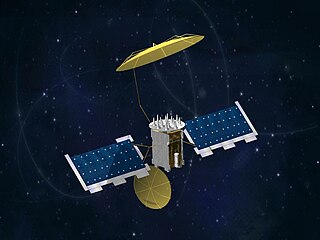
Milstar is a constellation of military communications satellites in geosynchronous orbit, which are operated by the United States Space Force, and provide secure and jam-resistant worldwide communications to meet the requirements of the Armed Forces of the United States. Six spacecraft were launched between 1994 and 2003, of which only five were operational after launch; the third launch failed, both damaging the satellite and leaving it in an unusable orbit.

The Mobile User Objective System (MUOS) is a United States Space Force narrowband military communications satellite system that supports a worldwide, multi-service population of users in the ultra high frequency (UHF) band. The system provides increased communications capabilities to newer, smaller terminals while still supporting interoperability with legacy terminals. MUOS is designed to support users who require greater mobility, higher bit rates and improved operational availability. The MUOS was declared fully operational for use in 2019.

United Launch Alliance, LLC (ULA), commonly referred to as ULA, is an American aerospace manufacturer, defense contractor and launch service provider that manufactures and operates a number of rocket vehicles that launch spacecraft into orbits around Earth and other bodies in the Solar System.

The Wideband Global SATCOM system (WGS) is a high capacity United States Space Force satellite communications system planned for use in partnership by the United States Department of Defense (DoD), Canadian Department of National Defence (DND) and the Australian Department of Defence. The system is composed of the Space Segment satellites, the Terminal Segment users and the Control Segment operators.

Advanced Extremely High Frequency (AEHF) is a constellation of communications satellites operated by the United States Space Force. They are used to relay secure communications for the United States Armed Forces, the British Armed Forces, the Canadian Armed Forces, the Netherlands Armed Forces and the Australian Defence Force. The system consists of six satellites in geostationary orbits. The final satellite was launched on 26 March 2020. AEHF is backward compatible with, and replaces, the older Milstar system and will operate at 44 GHz uplink and 20 GHz downlink. The AEHF system is a joint service communications system that provides survivable, global, secure, protected, and jam-resistant communications for high-priority military ground, sea and air assets.

USA-195 (32254), or Wideband Global SATCOM 1 (WGS-1) is a United States military communications satellite operated by the United States Air Force as part of the Wideband Global SATCOM programme. Launched Delta Heavy in 2007, it was the first WGS satellite to reach orbit. It is stationed at a longitude of 174.8° East, 6°e (10.2023), i=0°.

The Military Satellite Communications Directorate is a United States Space Force organization headquartered at Los Angeles Air Force Base, California. It is one of several wings and other units that make up the Space and Missile Systems Center (SMC).

USA-233, or Wideband Global SATCOM 4 (WGS-4) is a United States military communications satellite operated by the United States Air Force as part of the Wideband Global SATCOM program, started to orbit in 2012.
The fourth Wideband Global SATCOM satellite, it is the first WGS Block II satellite started Delta IV to supersynchronous geostationary transfer orbit. It is stationed at 88.5° East, 88.4°East i=0° (11.2023) in geostationary orbit.

USA-243, also known as WGS-5, is a United States military communications satellite. It was the fifth satellite to be launched as part of the Wideband Global SATCOM program and the second Block II satellite.

USA-204(34713), or Wideband Global SATCOM 2 (WGS-2) is a United States military communications satellite which is operated by the United States Air Force as part of the Wideband Global SATCOM programme. Started USSRs Atlas 5 in 2009, it was the second WGS satellite to reach orbit, and operates in geostationary orbit at a longitude of 60° East, 57°.5, 10.2023.

USA-211, or Wideband Global SATCOM 3 (WGS-3) is a United States military communications satellite operated by the United States Air Force as part of the Wideband Global SATCOM programme. Launched in 2009, it was the third WGS satellite, and final Block I satellite, to reach orbit. It is stationed at 12° West in geostationary orbit.

USA 244, a.k.a Wideband Global SATCOM 6 is a United States military communications satellite operated by the United States Air Force as part of the Wideband Global SATCOM programme.
Launched Delta IV in 08.08.2013UT(Z) to geostationary transfer orbit (GTO), it was the sixth WGS satellite to reach orbit.

USA 263, or Wideband Global SATCOM F7 is a United States military communications satellite operated by the United States Air Force as part of the Wideband Global SATCOM programm.
Started Delta IV in 2015 to geostationary transfer orbit (GTO), it was the seventh WGS satellite to reach orbit.

USA 275, a.k.a. Wideband Global SATCOM 9 is a United States military communications satellite ... operated by the United States Air Force as part of the Wideband Global SATCOM Die Support Programm.
Launched Delta IV to geostationary transfer orbit (GTO) in 2017, it was the ninth WGS satellite to reach orbit.

USA 291 (U.S.Strat.Com.:44071), or Wideband Global SATCOM 10 is a United States military communications satellite operated by the United States Air Force as part of the Wideband Global SATCOM programme.
Started Delta IV in 2019 to geostationary transfer orbit (GTO), it was the tenth WGS satellite to reach orbit.
It is in geostationary orbit, =60.3E i=0(from June 2021..10.2023]..).

WGS-11+, or Wideband Global SATCOM 11+, is a United States military communications satellite to be operated by the United States Space Force as part of the Wideband Global SATCOM Program. Scheduled for 2024, it is the eleventh WGS satellite and is expected to be in geostationary orbit. WGS-11+ was acquired by the United States Air Force.

The 53rd Space Operations Squadron is a United States Space Force unit. Assigned to the Space Operations Command's Space Delta 8, it is responsible for providing payload and transmission command and control of the Wideband Global SATCOM and Defense Satellite Communications System constellations. It is headquartered at Schriever Space Force Base, Colorado.










